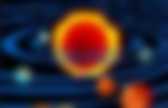

What's Your Favorite Planet? Distance from sun (avg.): 36 million miles Time it takes to orbit sun: 88 Earth days Size (diameter): 3,032 miles (two-fifths of Earth) Surface Temperature (range): -275 to 840 ºF Number of Moons: 0 Discovered: Known in ancient times Origin of Name: Roman god, the swift messenger Sean Solomon Carnegie Institution of Washington Principal Investigator for NASA's MESSENGER mission, which will reach Mercury in 2011.

Mercury is the underdog planet. It's the smallest guy in the neighborhood, and it lives in the roughest part of town—high temperature, strong solar wind. But little Mercury is tough. It's made out of the densest material. Distance from sun (avg.): 67 million miles Time it takes to orbit sun: 225 Earth days Size (diameter): 7,520 miles (roughly Earth-size) Surface Temperature (range): 113 to 870 ºF Number of Moons: 0 Discovered: Known in ancient times Origin of Name: Roman goddess of love. Mike Brown. Sand of Itokawa asteroid. Introduction In June 2010, the spacecraft HAYABUSA returned from asteroid Itokawa to the earth.
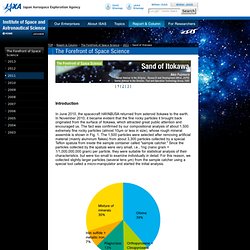
In November 2010, it became evident that the fine rocky particles it brought back originated from the surface of Itokawa, which attracted great public attention and encouraged us. The fact was confirmed by our compositional analysis of about 1,500 extremely fine rocky particles (almost 10µm or less in size), whose rough mineral assemble is shown in Fig. 1. The 1,500 particles were selected after removing artificial material (mainly aluminum flakes) from about 3,300 particles collected by a special Teflon spatula from inside the sample container called "sample catcher.
"
Predating The Solar System. The Solar system. Source: [accessed 2009] You may have wondered if there was a tenth planet out there. Wonder no longer; the astronomers have changed the meaning of the word planet so such pondering is no longer valid! Source: KBO's [accessed 2009] Our solar system is now filled with interesting things and I hope to go into many of them here. The references will no doubt go into them in even greater detail. Our solar system of course has a structure just like our galaxy has. Sun Moon Scope. Solar System Visualizer. Formation Stages. Interactive 3D model of Solar System Planets and Night Sky.
SolarBeat. NASA - JPL Solar System Simulator. The Solar System: The Sun, Planets, Dwarf Planets, Moons, Asteroids, Comets, Meteors, and Solar System Formation. The Nine Planets Solar System Tour. Magnetosphere. A magnetosphere is the area of space near an astronomical object in which charged particles are controlled by that object's magnetic field.[1][2] Near the surface of the object, the magnetic field lines resemble those of a magnetic dipole.
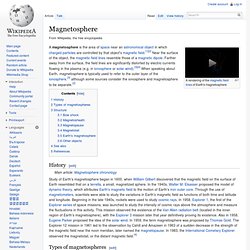
Farther away from the surface, the field lines are significantly distorted by electric currents flowing in the plasma (e.g. in ionosphere or solar wind).[3][4] When speaking about Earth, magnetosphere is typically used to refer to the outer layer of the ionosphere,[3] although some sources consider the ionosphere and magnetosphere to be separate.[2] History[edit] Types of magnetospheres[edit] Heliosphere & solar system info. This module serves as a background on the atmosphere.
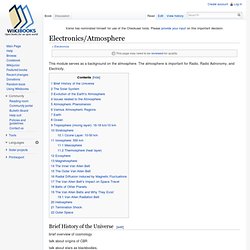
The atmosphere is important for Radio, Radio Astronomy, and Electricity. Brief History of the Universe[edit] brief overview of cosmology talk about origins of CBR talk about stars as blackbodies. Mercury & Venus The Inner Planets (The Universe 1) part 27 of 60. The Sun related to the solar system & galaxy.
Earth. Humanity. Australia. Life. Mars. Saturn. Moon. Dwarf Planets, Pluto Information. About Dwarf Planets The world was introduced to dwarf planets in 2006, when petite Pluto was stripped of its planet status and reclassified as a dwarf planet.
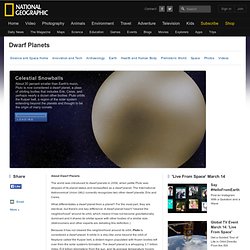
The International Astronomical Union (IAU) currently recognizes two other dwarf planets, Eris and Ceres. What differentiates a dwarf planet from a planet? For the most part, they are identical, but there's one key difference: A dwarf planet hasn't "cleared the neighborhood" around its orbit, which means it has not become gravitationally dominant and it shares its orbital space with other bodies of a similar size. (Astronomers and other experts are debating this definition.) Because it has not cleared the neighborhood around its orbit, Pluto is considered a dwarf planet. Pluto's surface is composed of a mixture of frozen nitrogen, methane, and carbon monoxide ices. Pluto has three known moons, Hydra, Nix, and Charon. In January 2006, NASA launched its New Horizons spacecraft en route to Pluto and Charon.
Dual Identity.
Pluto's Cousins. Eris. Vesta is 530 kilometers in diameter. NASA Dawn Spacecraft Returns Close-Up Image of Vesta July 18, 2011 PASADENA, Calif. -- NASA's Dawn spacecraft has returned the first close-up image after beginning its orbit around the giant asteroid Vesta.

On Friday, July 15, Dawn became the first probe to enter orbit around an object in the main asteroid belt between Mars and Jupiter. The image taken for navigation purposes shows Vesta in greater detail than ever before. When Vesta captured Dawn into its orbit, there were approximately 9,900 miles (16,000 kilometers) between the spacecraft and asteroid. Engineers estimate the orbit capture took place at 10 p.m.